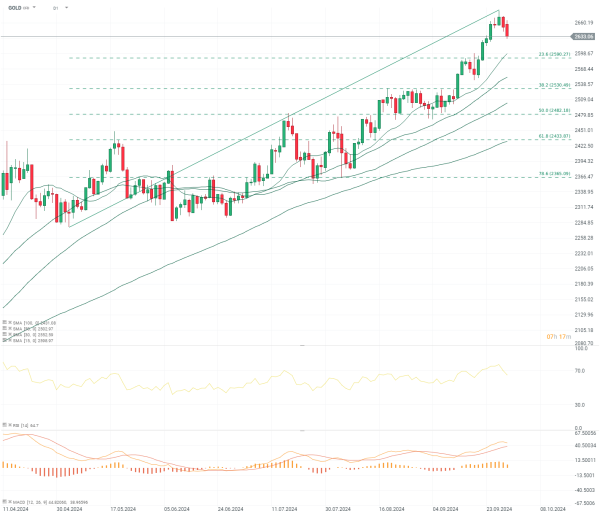Chart of the day - Gold (30.09.2024)
The gold market has experienced significant volatility today, with prices hovering near record highs despite a slight pullback of 0.7%. This comes amidst a complex backdrop of global economic developments, geopolitical tensions, and shifting monetary policy expectations. The precious metal is currently trading around $2,630 per ounce, slightly below its recent all-time high of $2,685.
Gold's resilience comes despite additional Chinese stimulus measures announced over the weekend. The People's Bank of China has called on banks to lower mortgage rates for existing home loans by the end of October, likely by 50 basis points on average. This move, aimed at supporting the country's property sector and broader economy, has had a mixed impact on gold prices.
The U.S. Dollar's performance has been a key factor influencing gold. The Dollar Index (DXY) is currently clinging to recovery gains, supported by Friday's cooler-than-expected U.S. PCE inflation data. The core Personal Consumption Expenditures (PCE) Price Index, the Federal Reserve's preferred inflation gauge, increased by 2.7% year-on-year, moving closer to the central bank's 2% target.
This inflation data has fueled market expectations for significant rate cuts by the Federal Reserve. Currently, traders are pricing in a 42% chance of a 50 basis point rate reduction in November, down from 54% on Friday. These expectations for looser monetary policy have been a major driver of gold's recent rally. The drop in jumbo cut expectations might be a reason for today's price action.
Adding to the complex market picture are escalating geopolitical tensions in the Middle East. Over the weekend, Israel continued to strike Lebanon and claimed to have killed another senior Hezbollah figure. Iran, which backs the powerful militant group, has vowed to retaliate, noting that the killing "will not go unanswered." These developments have heightened global uncertainties, potentially supporting gold's role as a safe-haven asset.
For traders and investors, key factors to watch in the coming days include:
- Federal Reserve Chair Jerome Powell's speech later today, which could offer insights into the central bank's policy outlook.
- This week's U.S. employment data, including ADP figures and the crucial Nonfarm Payrolls report.
- Any further developments in the Middle East conflict.
- The impact of China's stimulus measures on global economic sentiment.
Gold prices are likely to remain sensitive to these developments, as well as to any shifts in U.S. Federal Reserve policy expectations. The metal's recent rally has pushed it into overbought territory on technical charts, suggesting the potential for a short-term correction. However, the overall trend remains bullish, supported by geopolitical uncertainties and expectations of looser monetary policy.
Gold (D1 interval)
Gold is currently trading 0.7% lower today. The main reason might be the strength of the US dollar. First support for gold is 23.6% Fibonacci retracement level currently at $2590, so 40 dollars below current market price. It is also near the 15-day SMA which might help the price action. RSI is continuing its bullish divergence and is currently just below oversold levels. Any move above 70 would once again lead to gains in the price of gold. MACD is tightening however it also remains bullish. From a technical perspective key level will be previously mentioned support of $2590. Further downside could start trend reversal.
